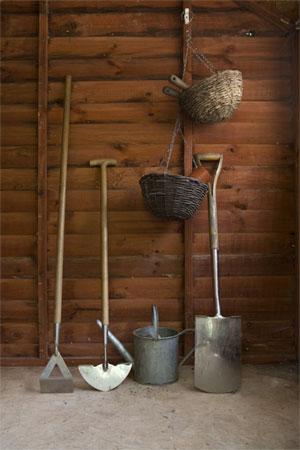You wouldn’t forget to wash your hands after ‘playing’ in the soil, so why should your garden tools get this treatment? Garden tools often get neglected and ignored until there is a major problem. With a little bit of maintenance at the end of the gardening season you can keep your tools looking like new for many years to come.
Remove the Dirt & Rust The type of tool determines the care that it receives. Digging tools, like shovels and hoes, need different maintenance and care compared to the pruning tools, like pruners and loppers. Digging tools, most commonly include shovels, hoes, pitchforks, and garden rakes. Routine maintenance should begin by removing any excess soil from the tool. It can be as simple as scraping off the excess soil, or as extreme as washing and drying the tool after every use, the choice is yours. Any rust that is present can be removed using a wire brush and a little bit of elbow grease or an electric drill with a wire brush or sanding attachment. After rust is removed, renew or sharpen the edges and points with a mill file or grinding wheel, be sure to wear protective eyewear.
For winter storage, apply a light coating of oil. Tools can even be stored in a 5 gallon bucket filled with sand and oil, either motor oil or vegetable oil. Inspect the handles of your tools at the end of the season for cracks or splinters. Replace the handles if necessary. If the wooden handles are in good condition, they can be sanded and oiled at least once a year. Use a fine grade sand paper to smooth the surface. Remove any dust and rub linseed oil into the handle and allow it to soak in. Keep applying until the oil doesn’t absorb any more. Wait a half hour, and dry off any oil remaining on the surface.
Sharpen Your Pruners Pruning tools, like hand pruners, loppers, or hedge shears, require a little different maintenance technique than digging tools. After each use, the cutting blades should be cleaned. Rubbing alcohol or a solvent like kerosene can be used to remove any sticky sap residue left on the blades. Prior to storage, apply a light coating of oil on the joints and on the exposed metal.
When it comes to sharpening your pruning tools, the type of tool and how you sharpen can make a difference. Sharp pruning tools will cut with less effort and the clean cuts promote faster plant healing. Inspect your pruning tools to see if they would benefit from a sharpening. With Anvil type tools, sharpen the cutting blade only on both sides, not the anvil portion. It is important that you don’t change the shape of the blade because it needs to sit flush against the anvil to provide clean cuts. With bypass type tools, sharpen the blade on the outside edge only. With both types of tools, try to maintain the original bevel angle of the blade to give you the best edge life.
To ensure you have the correct cutting angle on the blades, color the area to be sharpened with a black felt-tip pen before your start. Use a whetstone or oil stone and sharpen evenly until no trace of the ink can be seen on the blades. When sharpening, be sure to push away from the blade with the file or sharpening tool.
Personalize Your Tools Another good thing to do with your tools is to personalize them. How many times have you not seen the garden rake lying in the lawn or remembered which tools you borrowed from your neighbor? Use spray paint on the handles to find tools quickly and to identify yours’ from the neighbors’. Go green and use up any leftover paint from another project, or invest in the bright florescent pink paint that you have had your eye on. Whichever you choose, it will make finding and identifying your tools a snap.
